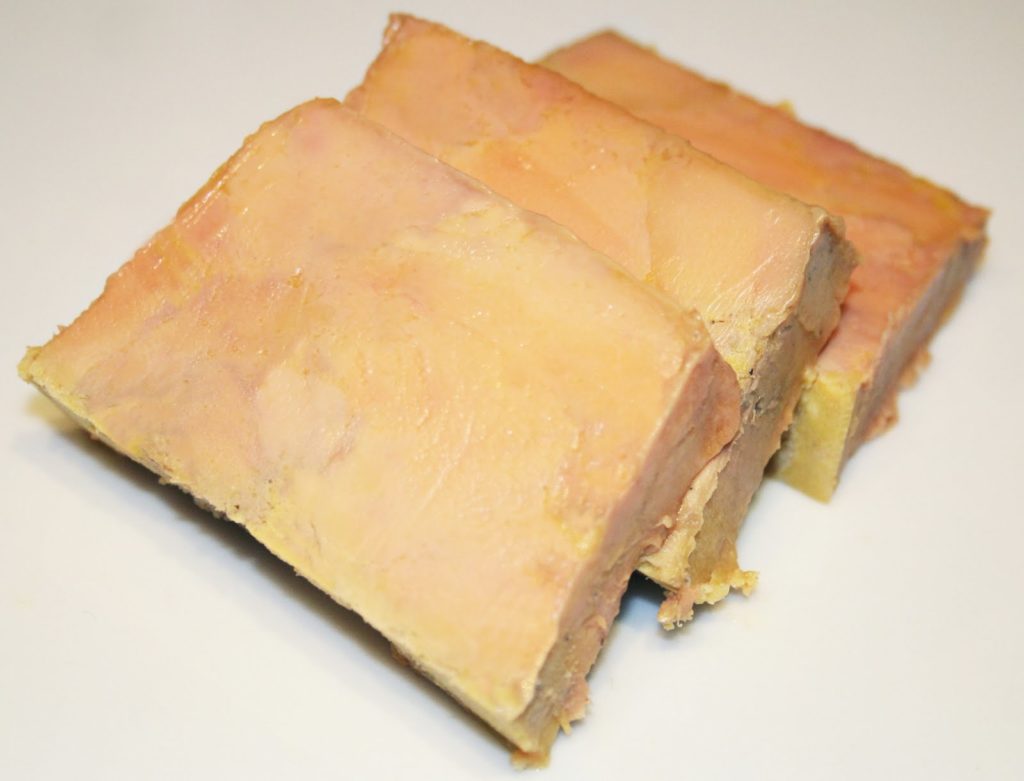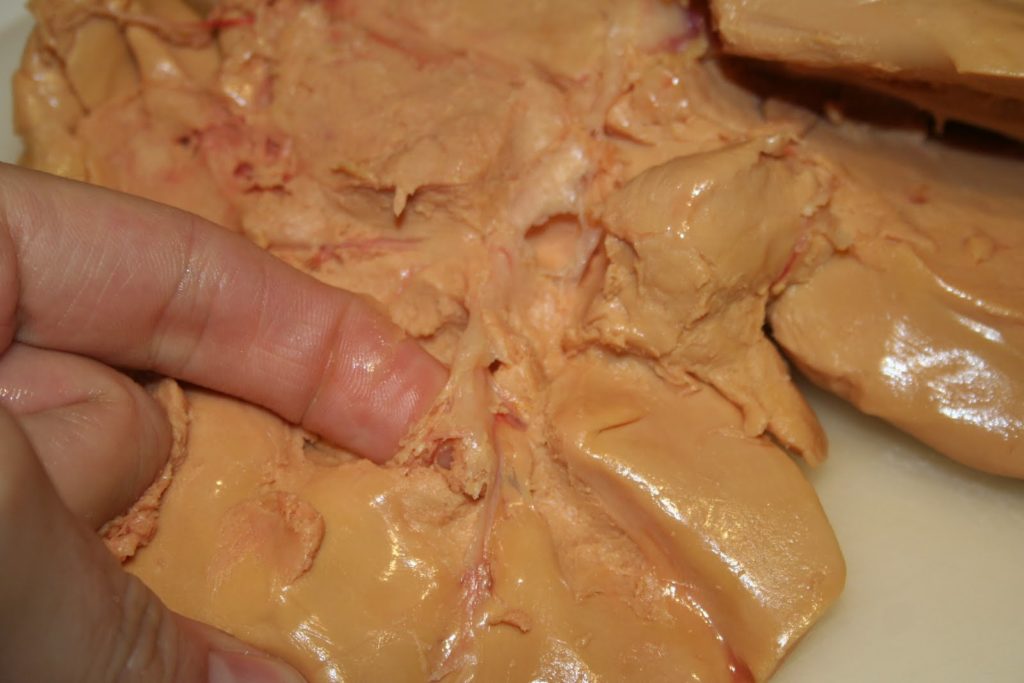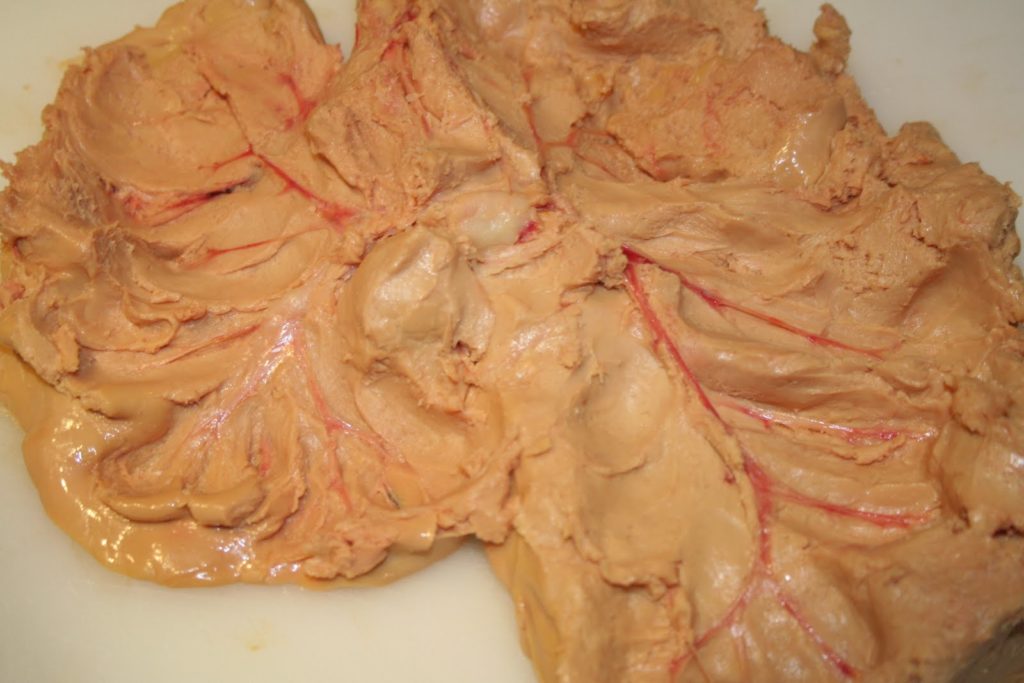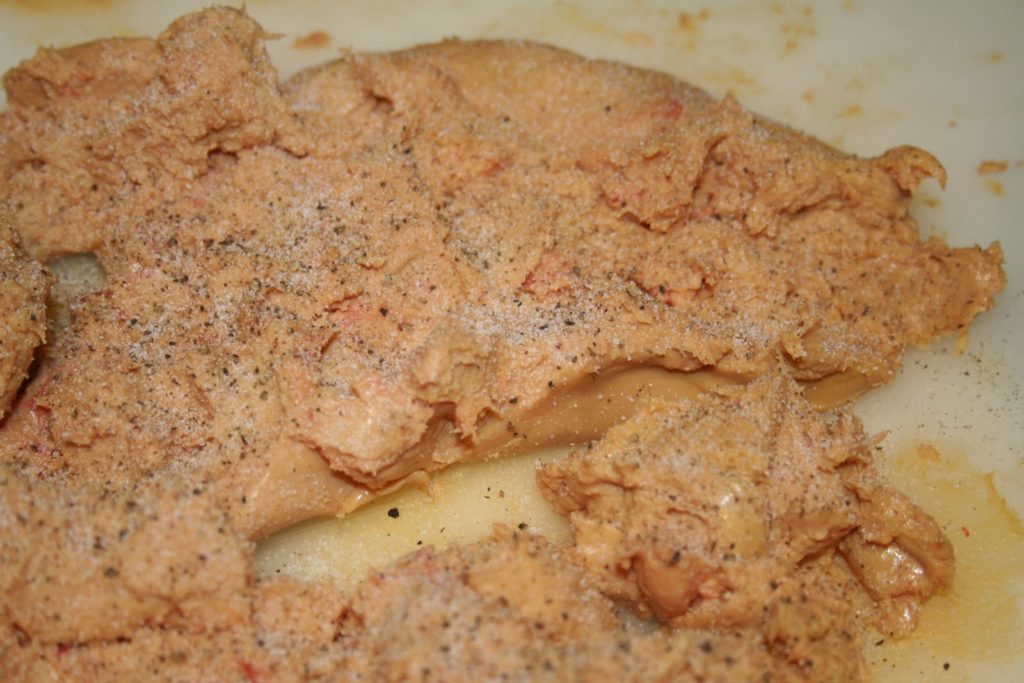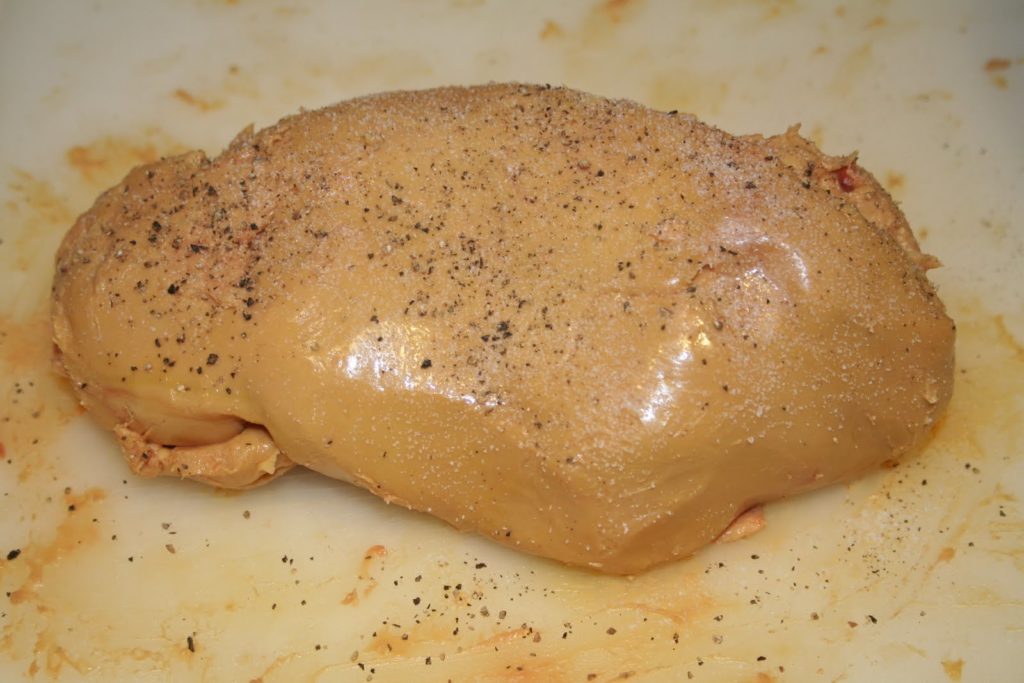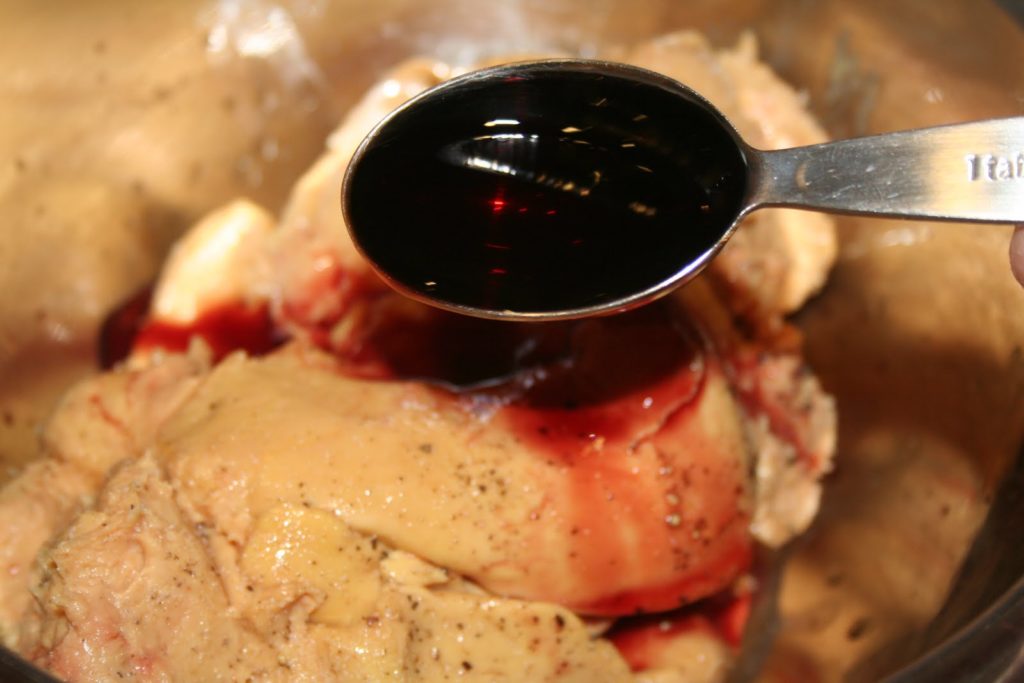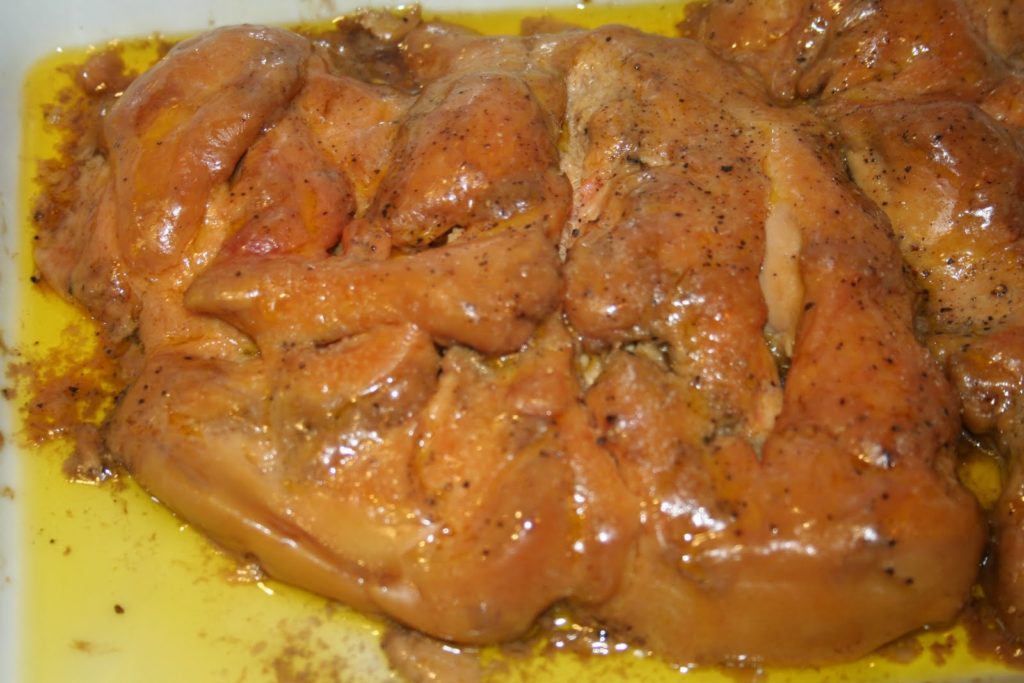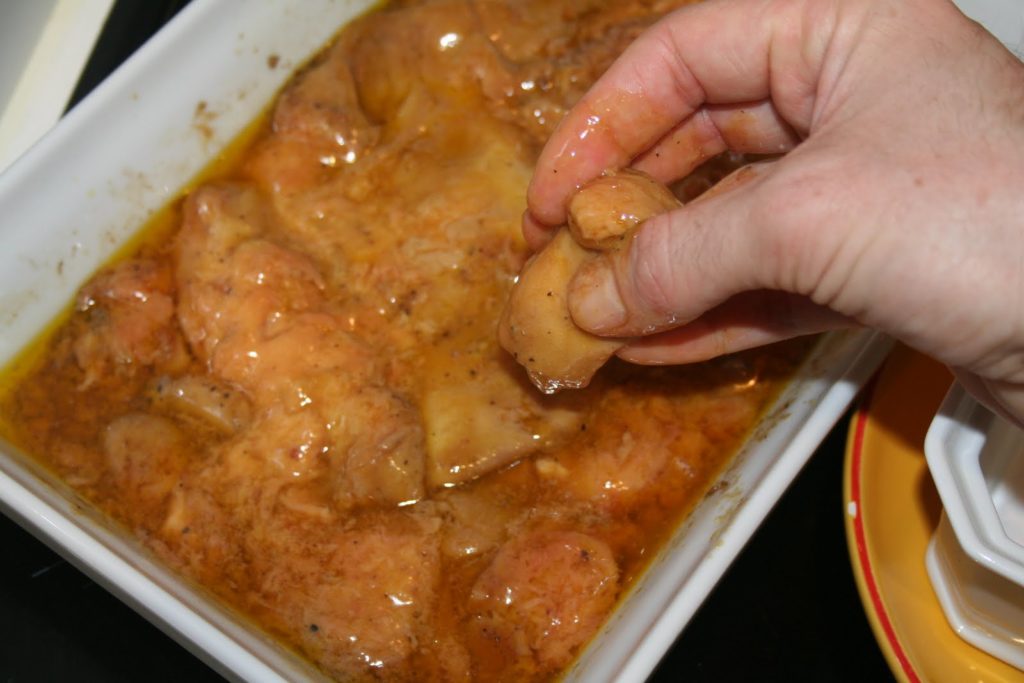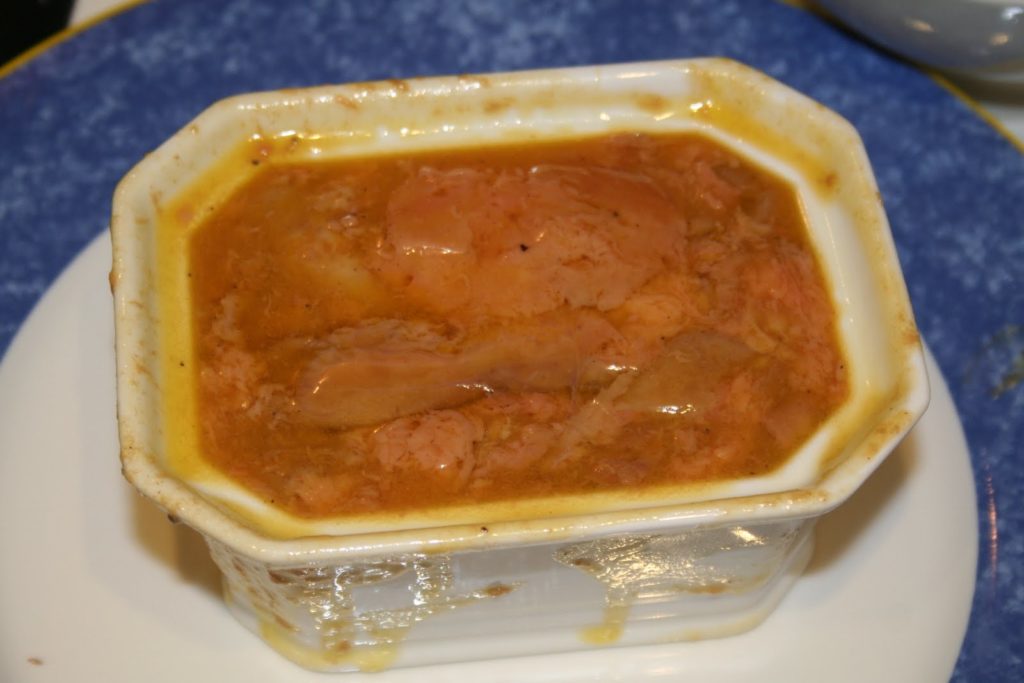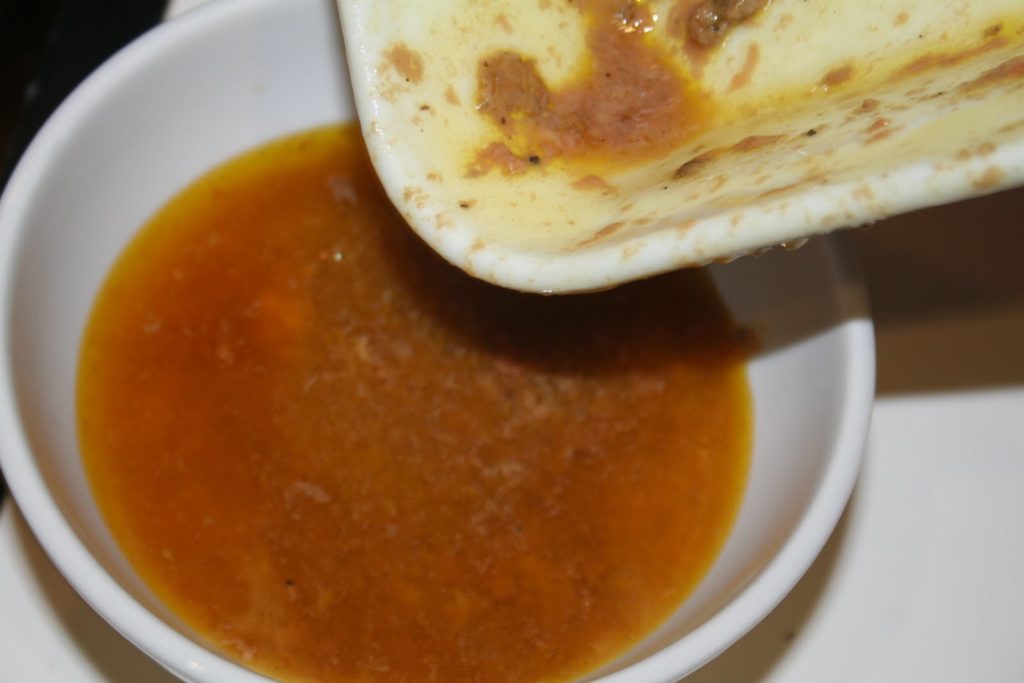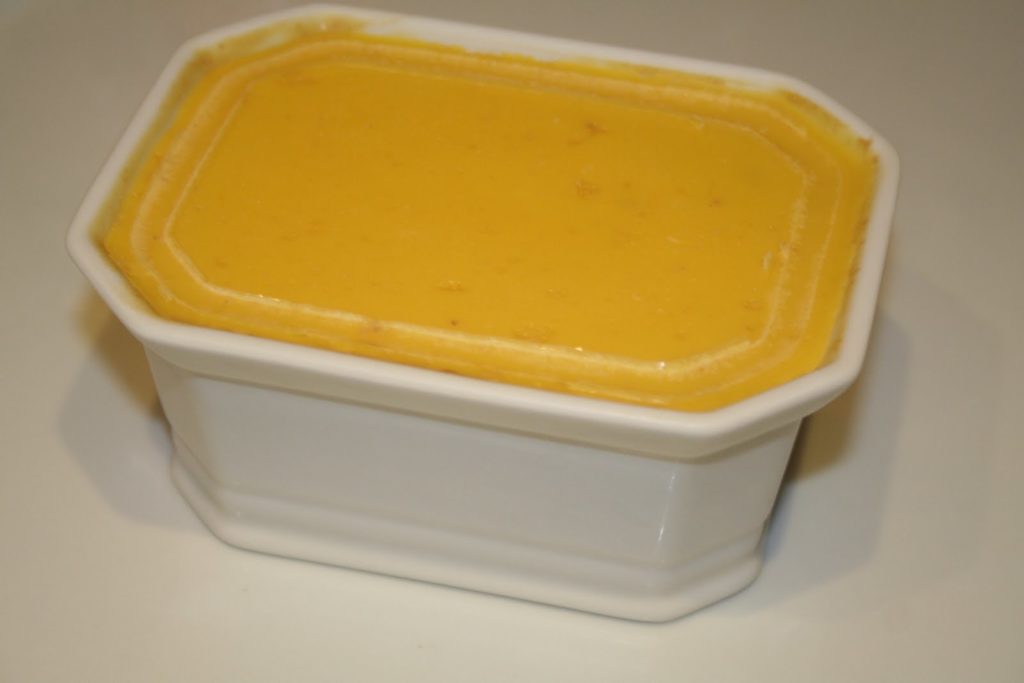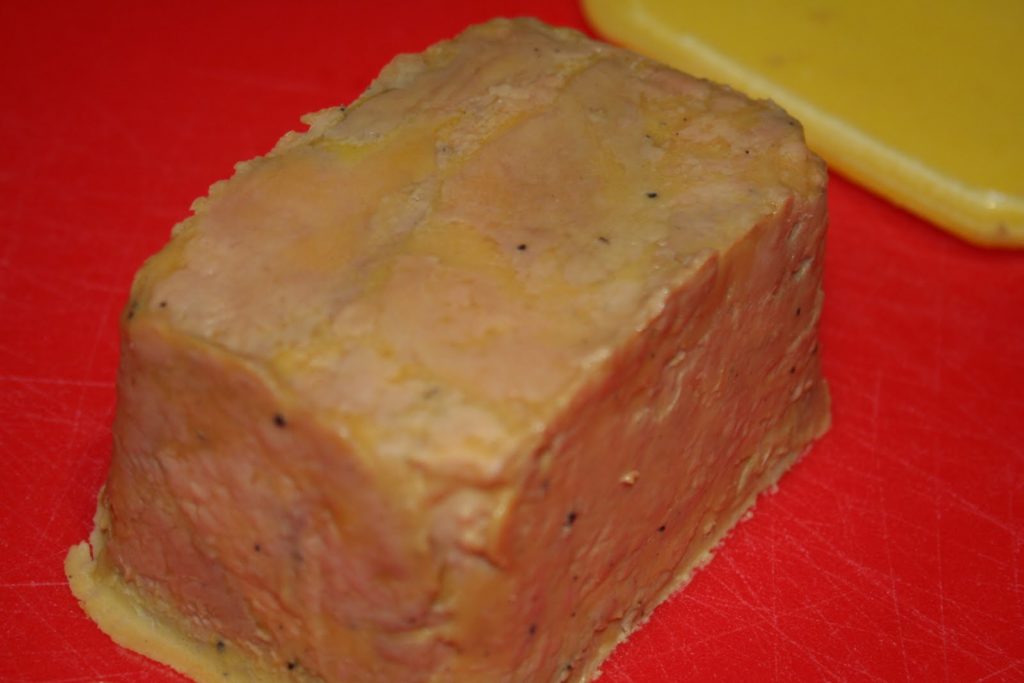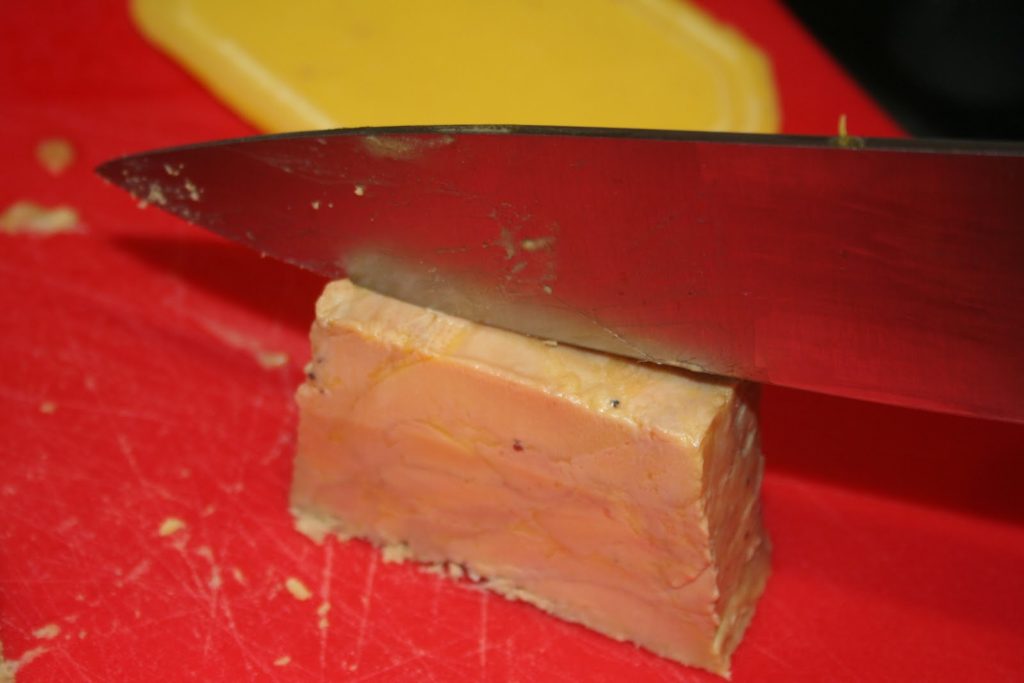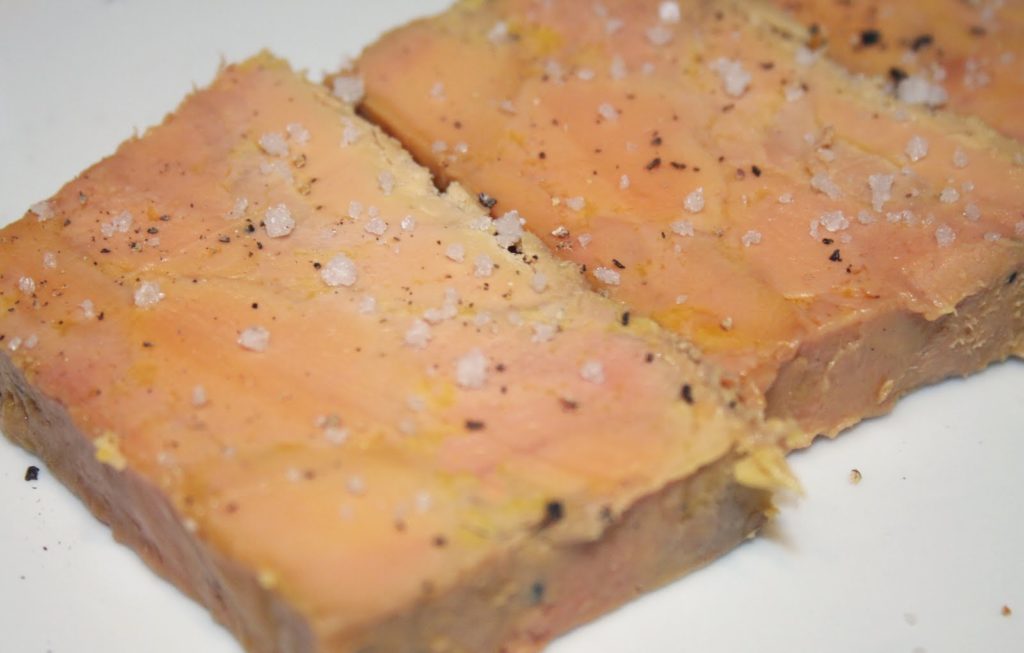915


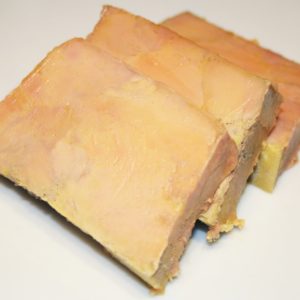
Foie Gras (1ère méthode en terrine)
Quoi de plus délicieux qu’une terrine de foie gras faite « maison »?! Je vous donne ici une première méthode de cuisson que j’utilise depuis presque douze ans… La prochaine est une méthode radicalement différente!Cette méthode est infaillible et très simple même si au premier abord elle parait périlleuse… Pour obtenir une bonne terrine de foie gras, plusieurs facteurs sont importants! Un foie gras de très bonne qualité, un assaisonement maitrisé, une cuisson parfaite et un temps de repos en terrine respecté! Je vous propose ici une version simple de foie gras,au porto et cognac, on peut bien sûr adapter au goût de chacun! Rhum et vanille, épices et piments, vin liquoreux et truffes, baies de Sichuan…. A chacun sa recette!!
Ingredients
Instructions
- Il faut sortir le foie gras cru au moins 2 heures avant de le déveiner. En fait tout dépend de la température de la pièce, disons plus simplement que le foie gras doit être malléable.
- Ouvrir le foie gras comme un livre. Les lobes s’ouvrent facilement si le foie est à la bonne température. On peut déjà voir les veines à l’intérieur et les suivre en passant le doigt dessous!
- Pour ma part j’ouvre complétement le foie et avec les doigts je dégage bien toutes les veines. Il y a déjà celles qui sont en photos mais il y en a aussi dessous. Il ne faut pas vraiment avoir peur de faire du mal au foie, à la cuisson celui-ci se remet parfaitement de cette étape! Alors pas de panique!
- Il faut ensuite enlever les nerfs/veines délicatement en tirant dessus sans les casser. Le plus gros lobe est le plus facile je trouve, le plus petit a beaucoup de veines et du coup il faut bien s’assurer que tout est parti!Une fois cette étape réalisée, on peut se dire que le plus dur est fait!Il faut maintenant assaisonner le foie. On peut choisir à ce moment ce que l’on souhaite. Je suis parti sur la recette porto et cognac.Saler et poivrer tout le foie, intérieur et extérieur… On peut également mettre une pincée de sucre.
- Fermer le foie pour lui redonner sa forme initiale et saler et poivrer le tout. Toujours une pincée de sucre. Bien frotter le foie avec le sel et poivre.
- Mettre le foie dans une jatte. J’ajoute à ce moment les alcools. Je mets une demi cuillerée à soupe de porto et une de cognac. Je repose le foie dans le bol et je passe bien les alcools sur toute sa surface comme si je le lavais avec ceux-ci. Réouvrir le foie pour passer les alcools dedans. A ce moment j’enlève l’éxcédent d’alcool car je trouve que sinon le foie est trop fort en alcool et le fait de l’avoir shampouinner avec tout ça suffit largement!
- Refermer le foie et placer un film étirable dessus, directement au contact. Le laisser reposer une nuit au frais ou alors l’après midi si le foie est préparé le midi.
- Le lendemain matin ou le soir donc, placer le foie ouvert (de nouveau) dans un plat à gratin. Laisser reposer le temps nécessaire pour que le foie soit à température ambiante.Préchauffer le four à 110°C.
- C’est maintenant qu’il va falloir être attentif mais rien de bien difficile!! Tout se fait tout seul! Le but de cette méthode que j’utilise depuis longtemps et que je contrôle la cuisson du foie. En effet j’ai toujours eu peur de cuire la foie directement en terrine avec un bain-marie etc…
- Avec cette méthode le foie ne surcuit pas. Et au pire il ne serait pas assez cuit mais dans une terrine le foie mal cuit se résume à un foie plus riche en gras et donc un peu plus solide (on pense souvent l’inverse) et on ne s’en rend même pas compte!
- Une fois le foie à température ambiante et le four à 110°C, placer le plat dans celui-ci. Je surveille le foie par tranche de 5 minutes. Les 10 premières minutes se passent sans souci. Puis il faut sortir à chaque 5 minutes le plat du four et mettre les mains dans le plat!! Le foie doit commencer à fondre légérement et être chaud/tiède au toucher. Il ne doit pas être frais ni trop chaud. Disons que la température idéale est comme celle d’un bon bain chaud. Bien sûr les les petits morceaux vont cuire plus rapidement, c’est pour cette raison qu’il convient de sortir le plat toutes les 5 minutes pour vérifier. Les petits morceaux cuits peuvent être placés dans une terrine! On placera tous les morceaux du foie au fur et à mesure dans la terrine.
- Le plus gros morceau, ou lobe, arrivera en dernier mais tout se fait assez rapidement. Il ne faut pas hésiter à mettre la main dans le plat pour toucher le foie qui doit avoir la température d’un bain chaud! En gros c’est ça qu’il faut retenir!
- Une fois tout le foie dans la terrine, on retient avec la main le foie et on penche la terrine pour enlever tout le gras en excédent. On peut même appuyer légérement sur le foie pour obliger le gras à sortir. On met le gras dans le plat à gratin avec le reste de gras. Quand la terrine est bien égouttée, on peut la nettoyer et la placer au frais.
- Verser tout le gras du plat à gratin dans un bol et le mettre également au frais.
- Quand la terrine est figée, mettre le bol de gras au micro onde une minute juste pour réchauffer et fondre le gras. Prélever juste du gras en surace avec une cuiller (ne pas prendre le fond du bol!!) et verser ce gras liquide sur la terrine jusqu’ couvrir entièrement le foie. De cette façon le foie est protégé de l’oxydation.
- Laisser faisander au moins 4 jours avant de consommer, jusqu’à 8 jours.
- Le jour J , enlever la couche de gras comme une plaque de cire, et passer la terrine à l’envers à l’eau très chaude, ou plonger la terrine à mi hauteur dans de l’eau chaude.
- Passer un couteau (passé à l’eau chaude) autour du foie dans la terrine, la renverser et démouler le foie gras.
- Je lisse le foie avec une lame de couteau et je remets le foie au frais pour refiger le pourtour qui aurait pu fondre un peu trop lors de l’étape du démoulage.
- Couper ensuite des tranches avec un couteau passé à l’eau très chaude.
- Présenter le foie avec un peu de fleur de sel et de poivre.
Notes
Accompagner de pain frais et de tout ce que l’on veut… Pain d’épices, confiture d’oignons, de figues, réduction de vinaigre balsamique…
Nutrition
Calories: 175kcalCarbohydrates: 5gProtein: 23gFat: 6gSaturated Fat: 2gPolyunsaturated Fat: 1gMonounsaturated Fat: 1gCholesterol: 644mgSodium: 660mgPotassium: 295mgFiber: 1gSugar: 1gVitamin A: 49886IUVitamin C: 6mgCalcium: 16mgIron: 38mg
Tried this recipe?Let us know how it was!
What could be more delicious than a “homemade” terrine of foie gras?! I give you here a first cooking method that I have been using for almost twelve years… The next is a radically different method!
This method is infallible and very simple even if at first glance it seems dangerous… To obtain a good terrine of foie gras, several factors are important! A very good quality foie gras, a mastered seasoning, a perfect cooking and a time of rest in terrine respected! I offer you here a simple version of foie gras, with port and cognac, we can of course adapt to everyone’s taste! Rum and vanilla, spices and peppers, sweet wine and truffles, Sichuan berries…. Everyone has their own recipe!!
Recipe for the “terrine of foie gras” for 4 people:
-a raw foie gras of “extra” quality about 500g
-port wine
-cognac
– salt/pepper/sugar
Start with the most painful step, especially for a novice!! But we can forget it if we decide to buy deveined foie gras. They sell it at G.Detou. (see section my addresses ).
Take out the raw foie gras at least 2 hours before deveining it. In fact everything depends on the temperature of the room, let’s say more simply that the foie gras must be malleable.
Open the foie gras like a book. The lobes open easily if the liver is at the right temperature. You can already see the veins inside and follow them by passing your finger under them!
For my part I completely open the liver and with the fingers I clear all the veins. There are already those that are in photos but there are also below. Do not really be afraid to hurt the liver, cooking it recovers perfectly from this step! So don’t panic!
The nerves/veins must then be gently removed by pulling on them without breaking them. The biggest lobe is the easiest I find, the smaller one has a lot of veins and so you have to make sure everything is gone!
Once this step is completed, we can say that the hard part is done!
Now we need to season the liver. We can choose at this time what we want. I went with the port and cognac recipe.
Salt and pepper all the liver, inside and outside… You can also add a pinch of sugar.
Close the liver to restore it to its original shape and season with salt and pepper. Always a pinch of sugar. Rub the liver well with salt and pepper.
Put the liver in a bowl. At this point I add the alcohols. I put a half tablespoon of port and one of cognac. I rest the liver in the bowl and pass the alcohols well over its entire surface as if I washed it with these. Reopen the liver to pass the alcohols through. At this time I remove the excess alcohol because I find that otherwise the liver is too strong in alcohol and the fact of having shampooed with all that is more than enough!
Close the liver and place a stretch film over it, directly in contact. Let it rest overnight in a cool place or in the afternoon if the liver is prepared for lunch.
The next morning or evening therefore, place the opened liver (again) in a gratin dish. Leave to stand for the time necessary for the liver to come to room temperature.
Preheat the oven to 110°C.
It is now that we will have to be attentive but nothing very difficult!! Everything happens by itself! The purpose of this method I have been using for a long time and control the cooking of the liver. Indeed I have always been afraid to cook the liver directly in a terrine with a bain-marie etc…
With this method the liver does not overcook. And at worst it would not be cooked enough but in a terrine the undercooked liver comes down to a liver richer in fat and therefore a little more solid (we often think the opposite) and we do not even realize it !
Once the liver is at room temperature and the oven at 110°C, place the dish in it. I monitor the liver in 5 minute increments. The first 10 minutes go smoothly. Then you have to take the dish out of the oven every 5 minutes and put your hands in the dish!! The liver should begin to melt slightly and be hot/warm to the touch. It doesn’t have to be cold nor too hot. Let’s say that the ideal temperature is like that of a good hot bath. Of course the little pieces will cook faster, it is for this reason that the dish should be taken out every 5 minutes to check. Small cooked pieces can be placed in a terrine! We will place all the pieces of liver as we go into the terrine.
The biggest piece, or lobe, will come last but it all happens pretty quickly. Do not hesitate to put your hand in the dish to touch the liver which must have the temperature of a hot bath! Basically, that’s what you have to remember!
Once all the liver is in the terrine, hold the liver with your hand and tilt the terrine to remove all the excess fat. You can even press lightly on the liver to force the fat out. Put the fat in the gratin dish with the rest of the fat. When the terrine is well drained, it can be cleaned and placed in a cool place.
Pour all the fat from the gratin dish into a bowl and also put it in the fridge.
When the terrine is set, put the bowl of fat in the microwave for a minute just to heat up and melt the fat. Take just excess fat with a spoon (do not take the bottom of the bowl!!) and pour this liquid fat over the terrine until the liver is completely covered. In this way the liver is protected from oxidation.
Leave to ferment for at least 4 days before consuming, up to 8 days.
On the D-day, remove the layer of fat like a layer of wax, and pass the terrine upside down in very hot water, or immerse the terrine halfway up in hot water.
Run a knife (under hot water) around the liver in the terrine, turn it upside down and unmold the foie gras.
I smooth the liver with a knife blade and I put the liver in the fridge to freeze the edges which could have melted a little too much during the unmolding stage.
Then cut slices with a knife washed in very hot water.
Present the liver with a little fleur de sel and pepper. Accompany with fresh bread and whatever you want… Gingerbread, onion and fig jam, balsamic vinegar reduction…

Foie Gras (1st method terrine)
What could be more delicious than a home-made terrine of foie gras?! I give you here a first cooking method that I have been using for almost twelve years… The next one is a radically different method! This method is infallible and very simple even if at first glance it seems perilous… To obtain a good terrine of foie gras , several factors are important! A very good quality foie gras, a mastered seasoning, a perfect cooking and a time of rest in terrine respected! I offer you here a simple version of foie gras, with port and cognac, we can of course adapt to everyone's taste! Rum and vanilla, spices and peppers, sweet wine and truffles, Sichuan berries…. Everyone has their own recipe!!
Tried this recipe?Let us know how it was!

